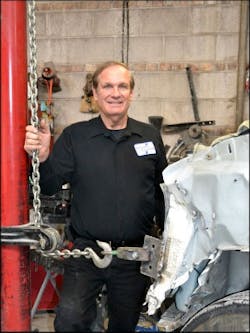At the core of every successful auto repair business is one simple, obvious similarity—one aspect of operations that can never be overlooked: quality repairs. That’s the bottom-line, price-of-admission expectation from customers in an increasingly competitive industry, Lois Schulte says.
“Repairs have to be accurate, correct and on time, or else nothing else you do matters,” says Schulte, the general manager of a seven-shop repair group in the Springfield, Mo., area that operates under two brands, Seeburg Muffler & Brake and A-1 Custom Muffler & Brake.
“You can overcome a lot of things, but that’s one thing that you can’t,” she adds.
It’s a lot easier said than done, though, as proper, consistent repairs require the proper tooling, equipment and training to keep up with ever-evolving vehicles.
For Schulte, this meant creating a culture of continuous improvement, building a company dynamic where employees focused on bettering themselves in order to push the company forward on its consistent growth pattern.
But in evaluating the $3.5 million–a-year company’s 20 technicians, Schulte was faced with an imposing question: “How do you get the technicians on your staff to want training?” she asks. “For some people, it’s natural, but what about the rest of your team? How do you create that culture?”
Schulte has spent the past two years developing her business’s answer.
The Backstory
In 1972, Jack Wiser founded the first Seeburg Muffler & Brake in Springfield. Over the next decade, he grew the business to five facilities, spreading into northwest Arkansas. His son, David, came on board as the general manager in 1987. David orchestrated the purchase of A-1 Custom, which has two locations in the Springfield area, and took over full ownership of the company with his wife, Audrey, when his father passed away.
Schulte has been a big part of the company’s extreme transition; for the past 20 years, she has worked nearly every position in the shop, going from a receptionist in the early 1990s to the company’s GM today.
“It’s always been a great place to work,” she says. “It’s always been a business that invested in itself, from equipment to training.”
The shops shifted from an under-the-car focus to general repair in the early 2000s, yet, Schulte says, retained its “expertise” in exhaust work. Roughly 30 percent of the business’s work now comes from exhaust, and it’s built a steady, consistent customer base.
None of the company’s locations are larger than 3,000 square feet. All are profitable.
“I’m very proud of the fact that through all the changes, we have developed a really good reputation,” Schulte says. “In this industry, you live or die by that reputation. It’s so important, and you can lose it in a hurry, too.”
The Problem
Schulte says the company values longevity in its employees; she’s proof of that. So, when the shops transitioned to full repair, it wasn’t a matter of hiring on new technicians. Schulte and the rest of the management team wanted to re-equip and retrain the team in place.
The transition was slow—it started with adding on oil changes then evolved from smaller work to full-on repairs. Maintenance and service packages were always a focus.
“We’ve always been lucky that the Wiser family has been extremely dedicated to making sure we have the most up-to-date equipment,” Schulte says.
The company also always subsidized training costs for technicians, offering numerous opportunities each year through local associations, suppliers and parts distributors.
Yet, few of the shop’s staff took advantage. Schulte has had a large budget set aside for training (roughly $20,000 per year), and leading up to 2012, it was rarely being used. She put a minimum-hours-per-year rule in place—just 20 hours—and few technicians would meet it.
“It goes back to quality of repairs,” she says. “We want to make sure every repair for every vehicle is correct, and to do that, we need to be as up-to-date on training as possible.”
“It wasn’t that we had no one who cared,” she adds. “We had a number of technicians who really put in the effort, but those were people who were already passionate about training and improving. The problem is, how do you get those who are uninterested in training to improve?”
The Solution
Schulte came to realize that the training program for the shops was too informal, and in 2012 set about a complete overhaul. Everything, she says, was focused on the concept of making sure those who completed the allotted hours (20) per year—or exceeded it—would be rewarded; those that didn’t, would lose out on opportunities for advancement.
The plan was simple, yet thorough. Schulte worked with her team of shop managers, the technicians and ownership to devise a program built around six key areas.
Goals. Every training program needs to have a clear goal in mind, Schulte says. For her shop, it was about maintaining the business’s high level of competency and having all technicians on staff working toward (or having achieved) ASE Master certification. To do that, Schulte says they kept the 20 hours per year of training (excluding certification courses and tests) as a bare minimum requirement.
Budget. This can vary greatly depending on a shop’s locations and needs, but taking into account the various discounted and/or free options available in her area, Schulte says they landed on a $1,000 per technician budget—roughly $20,000 company-wide for the year. This excludes all travel expenses, which are picked up by the shop on a case-by-case basis depending on the programs being taken, and the technician’s pay during training hours.
Training Options. Schulte works with her company’s various suppliers, jobbers and distributors to pick up as many training options as possible. The shop purchases packages from O’Reilly’s to be performed in house, it signs up techs for workshops in the region, and regularly sends team members to a five-day training Federal-Mogul holds in St. Louis. The shop also does training through ASA-Midwest, including sending staff to the VISION Hi-Tech Expo for a weekend of high-level of training in Kansas City each spring. Schulte compiles schedules of all available training and makes them available to staff. Team members can also request and attend additional training they find on their own.
Pay. Schulte says the company pays technicians for their time during training depending on the courses. She says it needs to be a commitment the staff member puts in to improve themselves; not a free day off work. Typically, if it’s a one-day session, the tech is expected to take personal hours for that session if it falls on a work day. If it’s a multiple-day program, the shop will pay them full wages for the remaining days.
Incentives. Schulte overhauled the company’s employee advancement structure and it is now predicated on training and education. Techs are assigned A, B and C designations based upon certification levels. Each level has different wage levels that techs can advance through depending on their amount of training hours completed that year. Technicians must complete their required 20 hours per year of training in order to be eligible for advancement. Techs also get a $100 bonus for each new certification they pass, $50 for each recertification.
Monitoring. Each technician’s training hours are monitored closely, and Schulte’s managers have regular review meetings with each employee. (Time of meetings vary between locations, depending on size of the shop.)
The Aftermath
It’s hard to truly gauge an employee’s motivation level, Schulte says, but as far as the success of the company’s training program, she can point to a few numbers.
The $20,000 budget was met in 2012, and was exceeded in 2013. Schulte says she expects to spend roughly $25,000 in training costs in 2014.
She had three technicians top 100 hours in training in 2013, and only two not meet the 20-hour minimum.
Total yearly sales also improved from $3.46 million to $3.55 million over that time.
Each shop monitors its technician efficiency in slightly different ways, Schulte says, making it difficult to give exact numbers that describe the staff’s technical improvements. However, she points to her Springfield A-1 Custom location as proof of the staff’s efficiency through training. The five-person, 2,000-square-foot location is on pace to top $1 million this year.
The Takeaway
As someone who’s played a large part in the company’s growth over the past 20 years, Schulte takes a lot of pride in the shops’ staying power in their communities. They are focused on maxing out production at each location, while continuing to offer customers an experience they can’t get elsewhere.
And that starts with quality repairs.
“That’s the absolute starting point if your shop is going to be successful,” Schulte says. “Everything starts there. That’s where you build your reputation, and that’s where you first earn people’s trust.
“A lot of times, you don’t get a second chance with a customer. We can’t afford to take those chances. We want to be as ready as possible for every vehicle that comes in our shops. I feel like we’re on the right path to doing that.”



